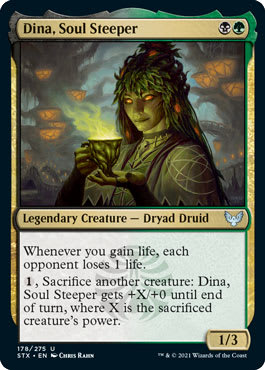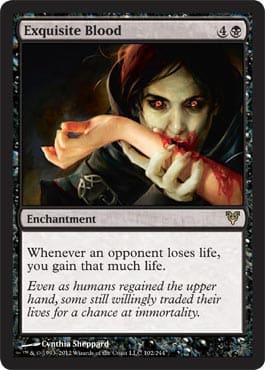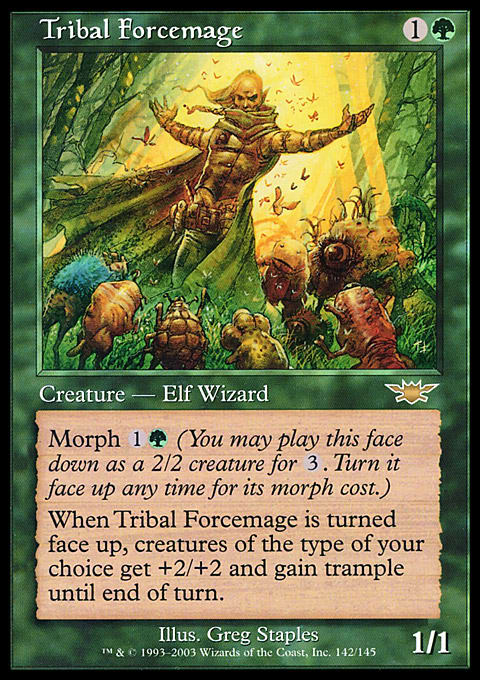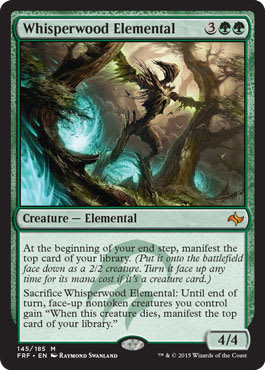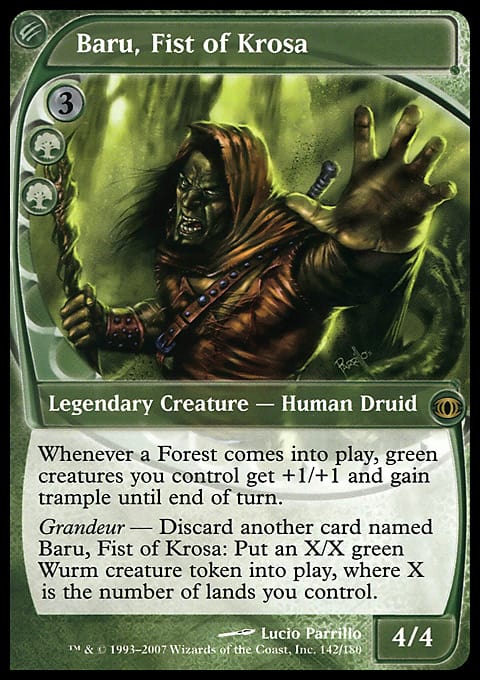
An Evening in Arcadia by Thomas Cole (1843). Memorial to Unity by Cliff Childs.
Not long ago I shared a deck list for Yedora, Grave Gardener that had a focus on making your lands into creatures. The concept was that you would play something like Life and Limb to set yourself up for some loopy combo fun or maybe an alpha strike out of nowhere. After playing a Ruxa, Patient Professor deck that was built around morph creatures and seeing what happened when Yedora was on the field, I realized that there was something bigger going on that I was going to need to dig into.
Today's column is a look at how I like to build combo decks and why certain types of combos are simply more effective and resilient than other types of combos. Before we launch into all of that, let's take yet another look at Yedora, Grave Gardener.
Yedora simply lets you take your nontoken creatures and when they die, have them come back onto the battlefield as a face-down forest. Those face-down cards are Forest lands, which means they can give you landfall triggers. If those face-down cards happen to have the Morph ability, they can be turned face up for their morph cost. If you're at all experienced with playing Magic or playing EDH, you probably know where this is going, but let me digress for a moment to talk about combo.
Efficiency, Redundancy and Resiliency
When you build a combo deck, you are building a deck that is playing a different type of game than the decks most of us played when we first learned about Commander. Our combo deck might be able to win through combat, but chances are good that we're going to try to assemble the right set of cards to be able to execute a loop that has a payoff of some sort that can win us the game.
The efficiency of your combo is a question of how many pieces there are to your puzzle and how easy those pieces are to assemble.
A two-card combo like Dina, Soul Steeper and Exquisite Blood is very efficient. You have one piece in your command zone and you're in Black so you can easily tutor for the piece that's in the 99 of your deck. That's about as efficient as you can get. Another great example is the old standard bearer, Mikaeus, the Unhallowed, which could combo with Triskelion to kill the table. If your goal is just to win the game, it's worth looking for compact, efficient combos. Having a low mana investment in the cards you need to win is also part of efficiency, so Dina would probably edge out Mike if I was trying to compare them against each other.
Redundancy is the number of possible backup options you have for each piece of your puzzle if your lowest mana value card isn't available or gets removed. Mikaeus can kill the table with Walking Ballista if he's got a sacrifice outlet on the field, but I'm not aware of any replacements for Dina's favorite enchantment, Exquisite Blood. My best example of great redundancy is my Grumgully, the Generous deck.
A tuned Grumgully persist combo deck will have a handful of possible replacements for each piece of the combo. The Great Henge, Melira, Sylvok Outcast and Rhythm of the Wild can all swap in for the role Grumgully plays in this deck. There are lots of creatures with persist and lots of sacrifice outlets in the list, though having both on one permanent in Aerie Ouphes makes that creature a particularly strong card. There are also loads of "payoff" cards like Impact Tremors and in some cases the payoff comes along with a sac outlet like with Tooth and Claw or Altar of Dementia. With so many redundant pieces to the core combo, if the game goes long enough it's hard not to pull into a way to win. This combo isn't as efficient, needing three or four cards to get the job done, but there can be a lot of redundancy across all parts of the combo.
Resiliency is all about how easy your combo is to stop. If you're bouncing a zero-cost Memnite to your hand and re-casting it in your Jhoira, Weatherlight Captain "cheerios" deck, that can be stopped at instant speed in a number of ways. A Chulane, Teller of Tales pilot might want to cast, bounce and re-cast Kor Skyfisher with Aluren on the field to draw their whole deck and put all their lands onto the field, but those castings can be responded to. These combos are very strong, but a counterspell or the right removal spell at the right time can trip them up.
A more resilient combo would be a combo that does not necessarily get stopped by stack interaction. If I'm playing Grumgully and I've got The Great Henge and Woodfall Primus on the field with a sacrifice outlet and an Impact Tremors, I can respond to interaction being put on the stack. If an opponent casts Nature's Claim to destroy my Impact Tremors, I'll sacrifice Woodfall Primus in response. That persist creature will will come back, damage my opponents and I'll hold priority and keep doing that. Aerie Ouphes is another great example of this kind of resiliency. You can sacrifice Aerie Ouphes to put damage to any targetable flyer on the stack. You keep priority and loop your Aerie Ouphes again and again, not letting the damage to the flyer resolve until you've successfully killed the table with whatever your payoff card happens to be.
Evaluating Yedora Morph Combo
Today's deck is a Yedora, Grave Gardener build that uses morph creatures to combo off and kill the table. The basic goal is to do something similar to what my Grumgully deck does. You want to set up a loop with a payoff that will win you the game. Where Grumgully has to work around creatures with the persist keyword, Yedora will work around creatures with the morph ability. There are a lot of those but only a few really work as a combo piece in this deck.
The reason for that is simple: we need to be able to bring back a morph creature as a face-down Forest and then pay its morph cost again and again and again. For Temur Charger, that's easy - we just reveal one of the Green cards we'll hopefully have in our hand. For morph creatures that cost a Green mana, we can bring them back as a face-down Forest, tap that for 1 Green and then use that mana to pay the morph cost. If we use a Phyrexian Altar as our sacrifice outlet that will put creatures with a morph cost of two mana into play. If we use an Ashnod's Altar, that will let us combo with creatures that have a morph cost of three. Making infinite mana is quite possible with the right setup.
With the right payoff you can just win. Altar of Dementia can let you mill your opponents out and unless they're on some degenerate graveyard combo deck you can pass turn and see them lose on their draw steps. There are also cards that can let you make your creatures arbitrarily large, though you'll want some with trample so you can be sure to push damage through. Getting an arbitrarily high life total is another great payoff that might not win you the game, but which should give you the time you need to either dig for the win or just whittle your opponents down until they're dead. Shooting your life total into the stratosphere usually means your opponents will have to resort to combo, commander damage, mill or infect to finish you off.
In terms of this deck's efficiency, redundancy and resiliency, I'd have to say that its biggest strength is the resiliency of the combo. In most cases you'll be able to respond to interaction well and your biggest fears will be split second instants like Sudden Spoiling or Krosan Grip and decks that are playing certain morph creatures. You can pay to turn a morph creature face up at any time - it doesn't use the stack and cannot be interacted with - so while you might think you're safe to combo you should be wary of anyone else with a face-down creature. They just might be able to stop your shenanigans.
The second strength of this deck is its redundancy. There are multiple options for morph creatures and lots of different payoff cards, but it doesn't reach the mark set by Grumgully. There is only one Yedora and if someone imprisons it in the moon, turns it into an indestructible bug or does something else to stop you from doing your thing, you'll be reduced to just playing a weird morph deck that probably has to go to combat to win. There's nothing wrong with winning games in the trenches, but this deck's ultimate goal is definitely to loop a morph creature.
Most of the combo wins you'll get with this deck will probably require four cards or occasionally three cards if you're looping with something like Altar of Dementia. That's pretty good, but doesn't really compare to two-card combo decks. This isn't some crazy Rube Goldberg device of a deck, but it's also not incredibly efficient, even with the creature tutors we'll have access to in green.
Beyond Morph
This deck's core is the Yedora morph creature interaction, but there are lots of fun little extras that are absolutely worth discussing. The first is something that is a lot like morph.
The manifest mechanic can put a card from your library onto the battlefield face down. It is a 2/2 creature, but most importantly, it is NOT a token. It is still a card and it is also a creature, and that's all Yedora really cares about. Scroll of Fate, Whisperwood Elemental, Arashin War Beast and Temur War Shaman can all help to make manifest creatures for you. If those face-down cards are morph creatures, you can turn them face up for their morph cost. If they die, they come back as a face down Forest.
It's hard not to like the value you'll end up getting out of this deck. I suspect that if you play it enough with the same people you might need to throw in some Swiftfoot Boots and Lightning Greaves for protection because if the deck does what it's supposed to do your friends will learn that they can't sleep on this Treefolk Wizard.
I don't know how many morph and manifest creatures I'll be able to get out at once, but Primal Whisperer feels like the kind of creature that will really do work eventually. With just four other face-down creatures he'll be a 10/10 and if I'm feeling whimsical I might just swing him face down at someone to see if they'll bother blocking a 2/2 or will just let it through. After blocks if he hasn't been dealt with I can pay his morph cost before the damage step and he'll get +2/+2 for each other face down creature I control. That means morphs and manifests count because they're creatures but those forests won't because they're lands.
Territorial Scythecat might not seem like a big deal, but each of my morph combo pieces that comes back onto the field will come back as a Forest. That means landfall triggers and with this kitty on the field if I can loop one of them I should be able to trample over and kill at least one opponent each turn until someone finds an answer. Oran-Rief Hydra is also in the list as a second trampler that gets +1/+1 counters with landfall triggers.
If I don't want to be limited to killing one player per turn, Baru, Fist of Krosa will turn all those Forest landfall triggers into pump and trample for all of my green creatures. I'll never use his grandeur ability, but as a combat finisher in this deck Baru looks just about perfect.
Yedora's Flippin' Forests
Most of my decks sit somewhere in the huge gap between precon level and fringe cEDH and this is no exception. This list reflects a build I've put together in paper. It's definitely missing cards that would be good for tuning it up towards higher-powered play if you wanted to push the power level up a bit. Yedora is in mono-Green so I don't see this list being able to get close to fringe cEDH, but you should be able to compete at higher-powered tables with the right adjustments. As always, adding fast mana, interaction and removal are keys to being able to play against stronger decks. You know your meta and the decks you'll be playing against so don't be shy about tweaking this list until it makes sense for what you're trying to do and who you're playing with.
Yedora's Flippin' Forests | Commander | Stephen Johnson
- Commander (1)
- 1 Yedora, Grave Gardener
- Creatures (44)
- 1 Aerie Bowmasters
- 1 Ainok Survivalist
- 1 Arashin War Beast
- 1 Arbor Elf
- 1 Baru, Fist of Krosa
- 1 Branchsnap Lorian
- 1 Broodhatch Nantuko
- 1 Caustic Caterpillar
- 1 Dawntreader Elk
- 1 Deathmist Raptor
- 1 Den Protector
- 1 Fauna Shaman
- 1 Fertilid
- 1 Fyndhorn Elves
- 1 Guardian Shield-Bearer
- 1 Hooded Hydra
- 1 Hystrodon
- 1 Kazandu Nectarpot
- 1 Kin-Tree Warden
- 1 Krosan Cloudscraper
- 1 Krosan Colossus
- 1 Lifeblood Hydra
- 1 Nantuko Vigilante
- 1 Oashra Cultivator
- 1 Oran-Rief Hydra
- 1 Pine Walker
- 1 Primal Whisperer
- 1 Protean Hulk
- 1 Quirion Ranger
- 1 Reclamation Sage
- 1 Root Elemental
- 1 Sagu Archer
- 1 Sakura-Tribe Elder
- 1 Salt Road Ambushers
- 1 Scute Swarm
- 1 Sporemound
- 1 Temur Charger
- 1 Temur Sabertooth
- 1 Temur War Shaman
- 1 Territorial Scythecat
- 1 Thelonite Hermit
- 1 Timeless Witness
- 1 Tribal Forcemage
- 1 Whisperwood Elemental
- Instants (2)
- 1 Force of Vigor
- 1 Summoner's Pact
- Sorceries (1)
- 1 Eldritch Evolution
- Enchantments (10)
- 1 Abundance
- 1 Blanchwood Armor
- 1 Death's Presence
- 1 Fecundity
- 1 Greater Good
- 1 Guardian Project
- 1 Obscuring Aether
- 1 Primitive Etchings
- 1 Sylvan Library
- 1 Trail of Mystery
The most glaring thing you'll notice about the list above is how many creatures I'm running. I'm all-in on the plan to be able to turn any boardwipe into ramp and since morph costs can get expensive, I think it's a pretty good plan. My only hesitation is in how few low-CMC creatures made the cut, and if I play the deck and find my early game is consistently slow I may have to drop some higher mana value creatures out.
I think a Yedora Morph build could probably play a very fun and resilient game without any of the combo elements in the list at all. It would be a very different deck than the one I've included above, but the fact that your creatures die and can be turned into Forests and brought back for their morph cost is an incredibly powerful ability. All those morph creatures don't have any real tribal synergy, and the power level of those morph creatures is somewhat limited but that doesn't mean there aren't the bones of a fun and very fair deck here if you were to strip out the combo stuff. You might consider running Mirage Mirror so that if all you need to combo is a permanent on someone else's battlefield, you can turn your mirror into a copy of the card you need to win the game and then blame your buddy for enabling your degenerateness.
Early Results
Even when I'm at a table where other players are trying to combo off, I always feel like I'm up to no good when I'm piloting a deck like Yedora. As you may know, I like to play these decks so that I can include a little feedback from actual gameplay. I was able to get this deck a couple of games last week in preparation for this column.
In both games my early turns were pretty underwhelming. The deck is running a few 1-drop mana dorks and a Sol Ring, but I had myself wondering if I shouldn't drop out some of the big morph creatures in favor of more early game mana sources. A 5-drop commander isn't cheap, and getting Yedora out early could result in having a bunch of extra forests if someone were to wipe the board without first removing my commander.
This deck actually did win one game, and in it I saw some valuable morph creatures get wiped away before Yedora came out, but I also got to see two creatures get hit by the first wave of a Massacre Girl ETB and get turned into Forests. Yedora died to that same ETB, but it was nice to have those extra lands on the field.
I might have been a bit outclassed by my tablemates' decks, but I was able to throw around removal, helping to stop other decks from landing a combo or getting too much value from a key permanent. It was definitely one of those games where I held back removal only to see a turn cycle go by and watch each of my opponents drop yet another thing I'd have been justified in blowing up. The thing about removal is that you have to be judicious about when you use it and it also helps to be lucky. Throw it around too much and you'll draw too much hate. Hold it back too much and someone could just win out of nowhere using something you didn't bother to deal with.
In the end I was able to get a creature with a one-mana morph ability onto the field with Yedora out and I was able to resolve Altar of Dementia. The guys had the chance to respond but none of them had any answers. One of the players was on a graveyard deck but we realized after a bit that the Altar of Dementia combo could remove anything he would be able to put on top of his deck to keep from drawing out and losing.
The best thing about playing combo is the suspense you feel as you're trying to assemble your wincon and then get it to come together to win you the game. You sit there wondering if your tablemates know how close they are to losing and whether they'll have the answers they need in order to stop you.
I topdecked my Altar of Dementia when I won that second game, so it was more a matter of me being lucky than anything else, but I'll take it. I did have that momentary sense of having a secret when I played my Altar and realized that it didn't seem like anyone was that concerned about it. They should have been, but if I hadn't won on that turn I found out later that someone else would have landed a combo on their next turn.
I was also able to play the deck online with my Tabletop Simulator group and got to do some really cool stuff with the deck. Sakura-Tribe Elder with a Quirion Ranger on the field is just bananas. You sacrifice Steve, it comes back as a Forest, you tap it for mana, bounce it to your hand with Quirion Ranger (only once per turn), and just ramp like crazy.
The deck was able to win that online game after I got a Phyrexian Altar out as a Manifest creature thanks to one of my editor's favorite cards: Whisperwood Elemental. I used it to block so it came back onto the field as a face-down Forest. I bounced it to my hand with Quirion Ranger, I played it, played a Temur Charger that I had tutored up with Summoner's Pact, and with Baru, Fist of Krosa on the field to pump my team I combo'ed off and swung for the win. It was goofy, it was gloriously convoluted, and it felt pretty great.
Final Thoughts
Today's column has me thinking about setting up a more structured way to "grade" combos. I definitely find that sort of discussion interesting, though I'm not looking to position myself as an expert on these things. Any grading system I set up would just end up being my opinion and my opinion is only as good as the analysis I back it up with. I do like the efficiency / redundancy / resiliency framework. Definitely let me know in the comments if a deeper dive into this subject would appeal to you.
Adventures in the Forgotten Realms is now in full preview mode so I expect in the weeks ahead to be turning my attention to some of the new legendary creatures coming out of that set. I actually played Dungeons and Dragons in the late 1970's back when it first came out, but I haven't played the game seriously in about 40 years. I'm also not that excited by the crossover into other IPs, so I'm not expecting to buy more than just isolated singles from that set. Still, I am hopeful there will be something I can get excited about in that set even if I'm heading into it with lowered expectations.
That's all I've got for today. Thanks for reading and I'll see you next week!

















